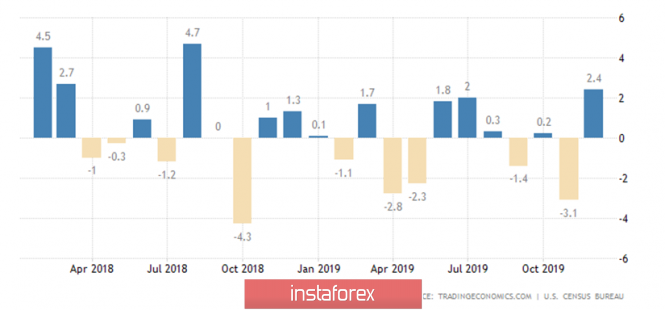4-hour timeframe

Amplitude of the last 5 days (high-low): 56p - 78p - 115p - 80p - 105p.
Average volatility over the past 5 days: 87p (average).
A new trading week for the GBP/USD currency pair begins with an upward correction. In general, the British currency's movement remains slurred and incomprehensible. On the one hand, a downward trend persists, which is more clearly visible on the 24-hour timeframe. On the other hand, the abundance of deep corrections against this very trend does not allow us to work it out confidently. Moreover, we believe that now the pound/dollar pair is faced with a kind of paradoxical situation, which we previously described in the euro/dollar pair. We have already said in previous articles that there are plenty of reasons to pull down the pound, but there are only a few reasons for its growth. However, the pair does not demonstrate the dynamics that we expect from it. Therefore, the solution to the problem may come as unexpectedly as for the EUR/USD pair - a strong downward movement will start in just one day.
As for the macroeconomic background, it is immediately worth noting that this week no important report will be published in the UK. Thus, both traders of the EUR/USD pair and traders of the GBP/USD pair will rely only on US statistics. However, with statistics from overseas, not everything will be smooth. For example, on Monday only the minor index of national activity of Chicago will be published, on Tuesday - the housing price index, and on Wednesday - the number of sales of new homes. Obviously, these reports will not cause any attention from traders. Thus, the first three days for the GBP/USD currency pair will be completely empty in the news plan.

Important information will begin to arrive from the United States on Thursday. The first report is orders for durable goods for January. In the past two years, growth and decline indicators have alternated, and the decline were often stronger than growth. In January 2020, it is expected that the main indicator will again lose 1.5% m/m. The second most important indicator of orders for durable goods, excluding defense and aviation orders, is expected with a loss of 0.1%.

Another no less significant indicator, excluding defense orders, is projected at +1.3% m/m. The latest report, excluding transport orders, is projected by experts at + 0.2%. It should be noted right away that forecasts and real values for all four reports rarely coincide, or at least are approximately equal. Typically, the discrepancies are very serious, so the forecast values are purely nominal. However, the reports themselves are important and cannot be missed.

Another significant indicator of the state of the US economy is the fourth quarter GDP, although only in a preliminary value. According to experts, the Gross Domestic Product will remain unchanged at +2.1%. Another publication of unimportant data on unfinished housing sales transactions will be released on Thursday, February 27.

Changes in the income level of the US population is set to be released on Friday.

... and the level of expenses. Both reports have more than neutral forecast values of +0.3% m/m. It should also be noted that these data rarely affect the mood of market participants. Therefore, one can hardly expect a strong market reaction if there are no serious deviations of the actual values from the forecast,. However, serious deviations are also not expected. If you look at the statistics for the last two years, it becomes clear that in most cases both indicators show a steady increase from 0.2% to 0.4%. The index of expenditures on personal consumption, the Chicago PMI and the consumer sentiment index from the University of Michigan are also slated for release on Friday, February 28. Also far from the most important data.
Thus, it turns out that the most important and, in fact, the only day when the macroeconomic background will really be strong is Thursday. Until then, respectively, the volatility for the pound/dollar pair may be low, and the trend may still be absent. However, despite the scarcity of the news calendar at first glance, one should not forget that at any moment information from Boris Johnson or Michel Barnier may be received regarding negotiations on a trade deal between the EU and Britain. But this information will definitely not be left without attention and may cause serious movements in the market.
From a technical point of view, the pound/dollar has now consolidated above the Kijun-sen line, so the downward trend has been canceled. Nevertheless, next week, technical factors will probably be the main ones, since the macroeconomic background is likely to be weak. The Senkou Span B line could not be overcome, so the downward movement may resume.
Trading recommendations:
GBP/USD began a new round of correction. Thus, it is recommended to sell the British pound with targets at 1.2867 and 1.2796 if the price consolidates back below the critical line. We recommend considering purchasing the pair with a target of 1.3041 if the upper boundary of the Ichimoku cloud is overcome.
Explanation of the illustration:
Ichimoku indicator:
Tenkan-sen is the red line.
Kijun-sen is the blue line.
Senkou Span A - light brown dotted line.
Senkou Span B - light purple dashed line.
Chikou Span - green line.
Bollinger Bands Indicator:
3 yellow lines.
MACD indicator:
Red line and bar graph with white bars in the indicators window.
Support / Resistance Classic Levels:
Red and gray dashed lines with price symbols.
Pivot Level:
Yellow solid line.
Volatility Support / Resistance Levels:
Gray dotted lines without price designations.
Possible price movements:
Red and green arrows.
The material has been provided by InstaForex Company - www.instaforex.com